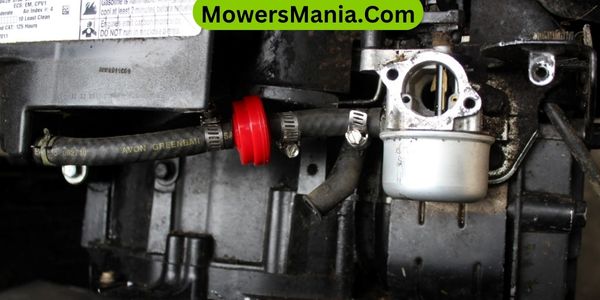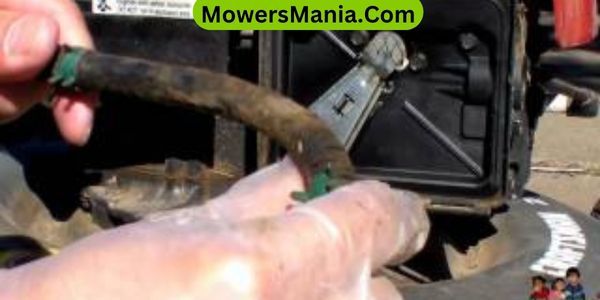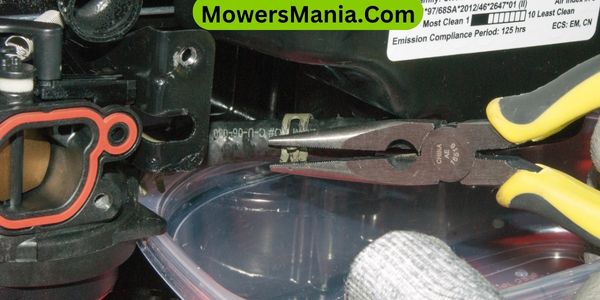If your lawn mower is sputtering and stalling, it’s likely time to clean the fuel line. In this article, you’ll learn how to locate, remove, clean, and reinstall the fuel line to get your mower running smoothly again.
With just a few simple steps and some basic tools, you can have your lawn mower’s fuel system in top shape in no time.

Locating the Fuel Line
To locate the fuel line on your lawn mower, start by examining the underside of the machine near the fuel tank. The fuel line is a small, flexible hose that carries gasoline from the fuel tank to the engine. It’s usually made of rubber or plastic and is typically about a quarter-inch in diameter.
Once you locate the fuel tank, follow the hose that leads away from it. This hose is your fuel line. It’s essential to identify the fuel line accurately before proceeding with any maintenance or cleaning.
When examining the fuel line, be sure to check for any cracks, leaks, or signs of wear. Over time, the fuel line can deteriorate due to exposure to gasoline and the elements, potentially leading to fuel leaks or blockages. If you notice any damage, it’s crucial to address it promptly to avoid potential safety hazards or damage to your lawn mower.
Remember that before handling the fuel line, it’s important to take proper safety precautions, such as wearing protective gloves and safety goggles. Ensuring that the fuel line is in good condition is an essential part of maintaining your lawn mower’s performance and safety.
Gathering the Necessary Tools
You’ll need a few basic tools to clean your lawn mower fuel line effectively.
First off, you’ll require a pair of safety gloves to protect your hands from any fuel spillage and to keep them clean while working.
Additionally, a set of screwdrivers, both flathead and Phillips, will be necessary to remove any covers or screws holding the fuel line in place.
A clean cloth or rag will come in handy to wipe away any dirt or debris from the fuel line and surrounding areas.
Furthermore, have a fuel line clamp or a pair of locking pliers to prevent fuel from leaking out while you work on the line.
A small container or gas can will be needed to drain any excess fuel from the line.
Lastly, keep a clean container to collect any fuel that comes out of the fuel line.
With these tools in hand, you’ll be well-equipped to effectively clean your lawn mower fuel line and ensure smooth operation of your equipment.
Removing the Fuel Line
Once you have gathered the necessary tools, carefully locate the fuel line on your lawn mower. The fuel line is typically a rubber or plastic hose that connects the fuel tank to the carburetor. It’s essential to handle the fuel system with care to avoid any spills or leaks.
To remove the fuel line, you will need to follow these steps:
| Step | Instructions |
|---|---|
| 1 | Ensure the engine is cool and the spark plug is disconnected. |
| 2 | Locate the fuel line and identify any clamps securing it. |
| 3 | Use pliers to gently squeeze the clamps and slide them away from the connection points. |
| 4 | Carefully twist and pull the fuel line to disconnect it from the fittings. |
| 5 | Once the fuel line is disconnected, inspect it for any signs of damage or debris. |
Cleaning the Fuel Line

You’ll want to start by removing any clogs effectively from the fuel line to ensure proper function. It’s important to take steps to prevent future blockages by using the right cleaning methods.
Make sure to use proper cleaning techniques to thoroughly clear the fuel line for optimal performance.
Removing Clogs Effectively
To effectively remove clogs from your lawn mower fuel line, start by locating the fuel filter. Once you have found the fuel filter, follow these steps to ensure successful removal of clogs:
- Disconnecting the Fuel Line:
Safely disconnect the fuel line from the filter to prevent any fuel from leaking.
Use a rag to catch any fuel that may spill out during this process. - Cleaning the Fuel Line:
Use compressed air or a thin wire to carefully remove any debris or clogs from the fuel line.
Ensure that the fuel line is completely clear before reattaching it to the fuel filter.
Preventing Future Blockages
Preventing future blockages in the fuel line involves regularly cleaning and inspecting the system for any debris or buildup. Additionally, using a fuel stabilizer and quality fuel can help keep the fuel line clean and prevent clogs.
Below is a table summarizing some preventive measures:
| Preventive Measures | Description |
|---|---|
| Regular Cleaning | Clean the fuel line and filter regularly. |
| Fuel Stabilizer | Add a fuel stabilizer to the gasoline. |
| Quality Fuel | Use high-quality, clean fuel for your lawn mower. |
| Proper Storage | Store the lawn mower with a full tank and stabilizer. |
| Inspection | Regularly inspect the fuel line for any signs of debris. |
Using Proper Cleaning
How frequently should you use a fuel system cleaner to maintain the cleanliness of your lawn mower’s fuel line? It’s recommended to use a fuel system cleaner every 6 months or after every 50 hours of usage to keep the fuel line free from debris and deposits.
To ensure proper cleaning of the fuel line, follow these steps:
- Choose the Right Cleaner:
- Select a fuel system cleaner specifically designed for small engines to ensure effective cleaning without causing damage.
- Follow Manufacturer’s Instructions:
- Always adhere to the manufacturer’s guidelines regarding the amount of cleaner to use and the proper application method.
Reinstalling the Fuel Line
Now that you’ve cleaned the fuel line, it’s crucial to secure the connections properly when reinstalling it.
Check for any potential leaks before starting the lawn mower, ensuring that the fuel line is free from any damage or wear.
Securing Fuel Line Connections
To begin, carefully reconnect the fuel line to the corresponding fittings on the lawn mower, ensuring a secure and snug connection.
- Double-check the orientation of the fuel line and fittings to avoid any potential leaks or disconnections.
- This will help prevent fuel spillage and ensure the proper functioning of the lawn mower.
- It’s important to listen for a click or feel for a firm attachment to confirm that the fuel line is securely connected.
Checking for Leaks
After securely reconnecting the fuel line, regularly inspect for leaks by visually examining the connections and feeling for any signs of fuel seepage. Start by checking the connection points between the fuel line and the mower’s fuel tank and carburetor.
Look for any visible signs of fuel leakage such as wet spots, drips, or stains around the connections. Additionally, run your fingers along the connections to feel for any moisture or fuel residue.
If you detect any leaks, immediately turn off the mower and address the issue before further use. Tighten the connections if necessary and replace any damaged or worn-out parts.
Regularly checking for leaks ensures that your lawn mower’s fuel system remains in good condition and prevents potential hazards.
Testing Fuel Flow
You can test the fuel flow by reinstalling the fuel line securely and priming the mower’s engine. Once the fuel line is reconnected and secured, follow these steps to ensure proper fuel flow:
- Prime the Engine:
- Press the primer bulb several times to draw fuel into the carburetor and create the necessary pressure for starting the engine.
- Check for Fuel Flow:
- Start the mower and observe the fuel flow through the line. A steady flow indicates that the fuel line is properly installed and the fuel is reaching the engine.
Following these steps will help you ensure that the fuel line is functioning correctly and that the engine is receiving an adequate fuel supply.
Testing the Fuel System

First, ensure the fuel shut-off valve is in the ‘on’ position before proceeding with testing the fuel system.
To test the fuel system of your lawn mower, follow the steps below:
| Step | Action | Purpose |
|---|---|---|
| 1 | Disconnect the fuel line from the carburetor. | This allows you to check the fuel flow from the tank. |
| 2 | Place a container under the fuel line. | This will catch any fuel that flows out of the line. |
| 3 | Turn on the fuel shut-off valve. | This will allow fuel to flow through the line. |
Once you have completed these steps, observe the fuel flow. If the fuel flows freely and consistently into the container, the fuel system is functioning correctly.
However, if there is little to no fuel flow, there may be a blockage in the fuel line or an issue with the fuel filter. Address any issues found before reconnecting the fuel line to the carburetor.
Testing the fuel system ensures that your lawn mower engine receives an adequate fuel supply for optimal performance.
Frequently Asked Questions [FAQs]
How Often Should I Clean My Lawn Mower Fuel Line?
You should clean your lawn mower fuel line at least once a year to ensure proper functioning. Regular maintenance can prevent clogs and fuel flow issues. Clear any debris and buildup to keep your mower running smoothly.
Can I Use Any Type of Cleaning Solution to Clean the Fuel Line?
You can’t use any cleaning solution to clean the fuel line. Use a specific fuel line cleaner recommended for your mower. Avoid using harsh chemicals or solvents as they can damage the line.
What Are the Signs That Indicate My Fuel Line Needs Cleaning?
If your lawn mower shows signs of sputtering, stalling, or loss of power, it may indicate a clogged fuel line. You can diagnose this by checking for fuel flow and address the issue promptly.
Is It Necessary to Replace the Fuel Line if It Is Severely Clogged or Damaged?
If your fuel line is severely clogged or damaged, it’s necessary to replace it. A compromised fuel line can lead to inefficiencies and potential safety hazards. Regularly checking and replacing damaged fuel lines is important for proper lawn mower function.
Are There Any Specific Safety Precautions I Should Take While Cleaning the Fuel Line?
When cleaning the fuel line, always wear protective gloves and eyewear to prevent injury from fuel spillage or fumes. Turn off the mower and disconnect the spark plug to ensure safety. Take caution with flammable substances.
Conclusion
Now that you’ve cleaned your lawn mower fuel line, you can rest assured that your mower will run smoothly and efficiently.
Regular maintenance of the fuel line will ensure that your lawn mower continues to perform at its best, so be sure to check and clean it regularly.
With the right tools and a little bit of effort, you can keep your lawn mower in top condition for years to come.



